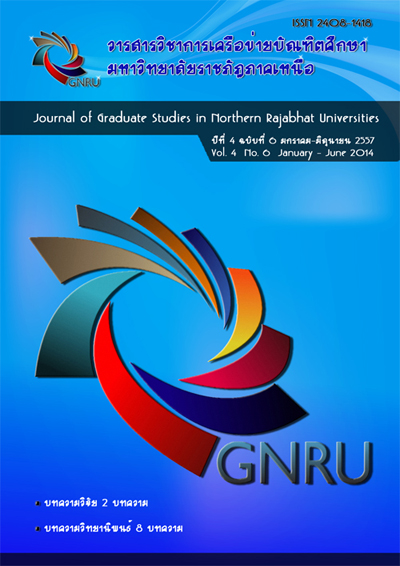พฤติกรรมการวางแผนทางการเงินส่วนบุคคล ของนักศึกษาสาขาการบัญชี คณะบริหารธุรกิจ โรงเรียนลาปางพาณิชยการและเทคโนโลยี; Behavior in Personal Financial Planning of the Students Majoring in Accounting, Faculty of Business Administration, Lampang College of Commerc
Main Article Content
Abstract
บทคัดย่อ
การวิจัยนี้มีวัตถุประสงค์เพื่อศึกษาพฤติกรรมการวางแผนทางการเงินส่วนบุคคล ของนักศึกษาสาขาการบัญชี คณะบริหารธุรกิจ โรงเรียนลาปางพาณิชการและเทคโนโลยี ประชากรที่ศึกษา ได้แก่ นักศึกษาระดับประกาศนียบัตรชั้นสูง จานวน 130 คน วิเคราะห์ข้อมูลโดยใช้สถิติพื้นฐาน ได้แก่ ค่าความถี่ ค่าร้อยละ ค่าเฉลี่ย และค่าเบี่ยงเบนมาตรฐาน
ผลการวิจัยพบว่า 1) ในภาพรวมพฤติกรรมการใช้เงินของนักศึกษามีค่าเฉลี่ยอยู่ในระดับพอใช้ โดยพฤติกรรมการใช้เงินด้านการศึกษามีค่าเฉลี่ยมากที่สุด รองลงมา คือด้านนันทนาการและกิจกรรมทางสังคม สาหรับด้านความจาเป็นพื้นฐานมีค่าเฉลี่ยต่าสุด 2) ผลการศึกษาการวางแผนการเงินส่วนบุคคล พบว่า ภาพรวมอยู่ในระดับปานกลาง เมื่อพิจารณาเป็นรายด้าน ด้านการกาหนดเป้าหมายที่ต้องการอยู่ในระดับมากที่สุด สาหรับด้านการวางแผนหาเงิน/เปลี่ยนงานอยู่ในระดับมาก ส่วนด้านการเก็บเงินออม ด้านจัดสรรเวลาเพื่อหาความรู้ ความเข้าใจในการลงทุน และด้านการบริหารภาระหนี้สิน อยู่ในระดับปานกลาง 3) ผลของบันทึกบัญชีส่วนบุคคลพบว่า ในระยะเวลา 1 เดือนรายรับส่วนใหญ่มาจาก รับเงินจากผู้ปกครอง อันดับสองจากเงินกู้ยืมเพื่อการศึกษา และรายได้จากการทางานพิเศษเป็นอันดับสุดท้าย รายจ่ายส่วนใหญ่เป็นค่าอาหาร ค่าใช้จ่ายเพื่อการศึกษา ค่าใช้จ่ายอื่น ๆ ค่าใช้จ่ายเกี่ยวกับยานพาหนะ ค่าหอพัก ค่าโทรศัพท์ ค่าของใช้ และค่ารักษาพยาบาล ตามลาดับ และเมื่อพิจารณาของรายรับจานวน ร้อยละ 100 มีรายจ่าย จานวนร้อยละ 95.20 คงเหลือเงินออม ร้อยละ 4.80
Abstract
The purpose of this research was to study behavior in personal financial planning of the students majoring in accounting, Faculty of Business Administration, Lampang College of Commerce and Technology. The population were 130 students. Data were analyzed by using descriptive statistics which were frequency, percentage, average and standard deviation. The major findings revealed that the spending behavior of students as a whole was at the medium level. The behavior of spending on education came first, followed by recreational social activities, whereas basic needs came last.
The results of the research of personal financial planning found that, overall it was at the average level. When considered by each aspect, expected targeting was at the highest level. Planning for money / changing of work was at the high level. Saving the money, and The time allocated for understanding of the investment and management of reliability were at the lowest level. And the study of personal accounts found for 1 month revenues mainly came from parents. Second was from loans for education and income from extra work came last. Most expenses were for food and for education. Other expenses were for the vehicle, accommodation fees, telephone bill, daily things for use and medical fee respectively. From the revenue of 100 percent and the expenditure of 95.20 percent, the remaining would be 4.80 percent savings.

